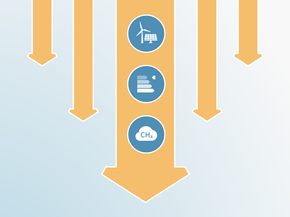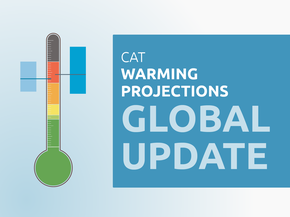Assumptions
Historical emissions
Historical emissions data cover the period 1990–2024. They are taken from Australia’s emissions projections 2024 (DCCEEW, 2024b) and the September 2024 Quarterly Update of Australia’s National Greenhouse Gas Inventory (DCCEEW, 2025d).
NDC and other targets
Conclusions of the present CAT assessment are subject to uncertainty in light of Australia’s frequent revisions of its emissions data. The government has repeatedly revised emissions projections downwards. This has typically not been backed by stronger climate policies but is rather the result of a change in assumptions.
The government has set an emissions reductions target of 43% below 2005 levels including LULUCF. To recalculate this target excluding LULUCF, we determine the targeted emissions level in 2030 including LULUCF (i.e. 43% below 2005 levels), then subtract LULUCF sequestration projected by the government for 2030. We then compare this projected emissions level excluding LULUCF in 2030 to 2005 emissions excluding LULUCF. We recalculate the NDC target excluding LULUCF every time the historical and projected emissions are updated.
LULUCF projections in this CAT update are taken from Australia’s emissions projections 2024 (DCCEEW, 2024b).
Current policy projections
The current policy projections are presented as a range, reflecting uncertainty around the pace of renewable energy deployment in Australia. The range is based on government projections from 2024 (DCCEEW, 2024b), harmonised to the September 2024 Quarterly Inventory data, published in 2025 (DCCEEW, 2025d), and IEA forecasts for renewables rollout (IEA, 2025). The CAT always provides policies and action projections excluding LULUCF. To this end, the CAT subtracted the projections provided for LULUCF.
Given that the pace of renewable energy deployment is falling short of what is needed to meet the 82% target by 2030, the government’s projections appear optimistic. To account for the risk that the government’s target for 2030 may not be met, we constructed a range in which only the power sector assumptions differ.
All the other sectors are based on the ‘baseline’ scenario of the government’s 2024 projections. The baseline scenario includes current policies and measures and announced policies where there is sufficient detail to make robust assumptions in the modelling” (DCCEEW, 2024b). This includes the expanded Capacity Investment Scheme (CIS), Safeguard Mechanism reforms, Powering the Regions Fund, and New Vehicle Efficiency Standard (NVES). The full list of policies integrated in this scenario is available in the 2024 projections (DCCEEW, 2024b).
- The lower end of the current policy projections assume that the government achieves its 82% renewable electricity target. All other sectors remain aligned with the government’s baseline scenario.
- The upper end of the current policy projections is based on IEA forecasts, which projects renewables reaching 58% of the power mix by 2030 (IEA, 2025). All other sectors remain aligned with government’s baseline scenario.
The IEA-based scenario for the power sector assumes that fossil fuel generation shares per source and total demand remain the same as in the government projections (DCCEEW, 2024b). Aggregate fossil fuel generation is adjusted to meet the IEA’s 2030 renewable target by interpolation from 2024 to 2030 (IEA, 2025). Historical emission factors from 2019 to 2024 calibrated to the projections’ power sector emissions pathway then allows the resulting emissions to be derived (Open Electricity, 2024a). After 2030, this scenario assumes that power sector emissions continue to decline at the same rate as in the projections (DCCEEW, 2024b).
Planned policy projections
The announced policy projections align with the ‘with additional measures’ scenario of the 2024 government projections, which includes policies that “have been announced but where detailed design is still under consultation” (DCCEEW, 2024b).
The ‘with additional measures’ scenario includes the National Hydrogen Strategy, released in September 2024, the Critical Minerals Production Tax incentive, and the Industrial Transformation Stream of the Powering the Regions Fund.
Net-zero target and other long-term targets
We use the most recent available update of the Long-Term Emissions Reduction Plan as a basis for assessing Australia’s climate trajectory to 2050. The government is currently preparing an update of the 2050 Net Zero Roadmap.
To assess the net zero target, we used the scenario “The Plan”, modelled by DISER (Australian Government, 2021c). “The Plan” scenario incorporates a sequestration of 38 MtCO2e through bioenergy with carbon capture and storage (BECCS), which is considered in our target assessment.
Global Warming Potentials
The CAT uses Global Warming Potential (GWP) values from the IPCC's Fifth Assessment Report (AR5) for all its figures and time series unless stated otherwise. Assessments completed prior to June 2025 used GWP values from the Fourth Assessment Report (AR4), and those completed prior to December 2018 (COP24) used GWP values from the Second Assessment Report (SAR).
Further analysis
Latest publications
Stay informed
Subscribe to our newsletter




